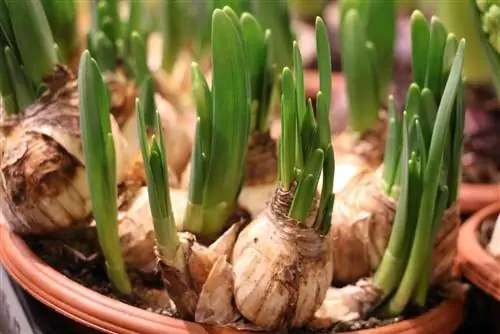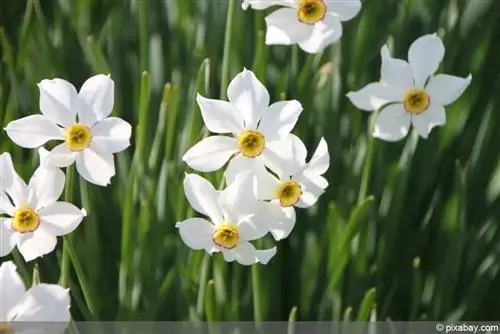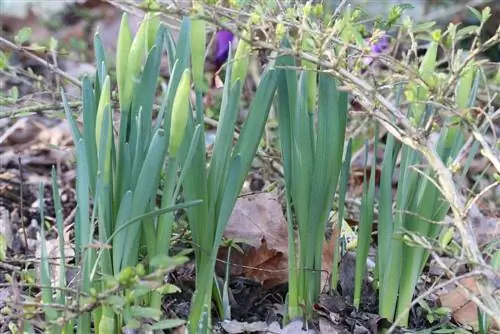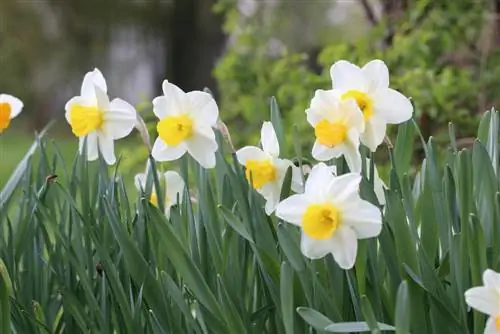- Author admin [email protected].
- Public 2023-12-17 03:39.
- Last modified 2025-01-24 12:45.
Everyone knows daffodils. The gardening year basically begins with them. The poet's daffodil, on the other hand, is much less well known, although both flowers are species of daffodil. The fact that the poet's daffodil is somewhat overshadowed by the daffodil is actually not justified - and is reason enough to take a closer look at this wonderful plant, its cultivation in the garden and its care.
Profile
The poet's daffodil, whose Latin name is Narcissus poeticus and which is also often called the white daffodil because of its white flowers, is now threatened with extinction in the wild. It is therefore also a protected species. Poet's daffodils in our gardens are a special breed that goes back to the wild original species. One of the most widespread varieties is the so-called Actaea.
In contrast to other types of daffodils such as the daffodil or the much better known yellow daffodil, it exudes a light, pleasant scent. It reaches a height of up to 40 centimeters and particularly scores with its white, delicate petals. Narcissus poeticus blooms a little later than other daffodils, usually at the end of April or mid-May.
Planting
Poet daffodils grow out of a bulb. As a result, they are usually only available as bulbs in garden centers, garden shops or hardware stores. They can generally be planted in the garden from late summer to autumn. The months of September to November have proven to be the ideal planting time. However, when planting, it must be ensured that the soil is frost-free and relatively loose.
You should be careful and wear gloves both when storing the bulbs and when planting them. The onions are poisonous and can cause skin irritation. At the same time, this toxicity ensures that the onion in the ground is safe from predators and is particularly avoided by voles. When planting, proceed as follows:
- Loosen the soil well in advance and dig planting holes
- Place the onions up to 15 centimeters deep in the soil and then cover them loosely with soil
- the tip of the onion must point upwards
- Rule of thumb: The planting depth should be approximately twice to three times the bulb size
- When planting several bulbs, keep a distance of about ten centimeters between them
- water well immediately after planting, but avoid waterlogging
Tip:
Poet daffodils often grow in large groups in so-called daffodil meadows in the wild. If you want to achieve a similar effect in your own garden, throw a handful of onions randomly onto the ground before planting and then stick them into the loose soil where they landed.
Soil or soil

The poet's daffodil is a really undemanding plant in many respects. This also explicitly applies to the floor. Above all, it should be relatively low in lime, loose and reasonably rich in humus. If you are dealing with soil that has a lot of clay in your garden, it is recommended to dig up the soil and mix it well with sand and humus. In addition, a drainage layer made of sand or pebbles should also be created in the planting hole for Narcissus poeticus. Daffodils cannot tolerate waterlogging, which is why it is important for their survival that excess irrigation or rain water can drain away without any problems.
Location
The right location plays a major role in ensuring that plants can grow and thrive optimally. This of course also applies to daffodils and Narcissus poeticus. They feel most comfortable in a sunny to partially shaded location. At the same time, it should be ensured that it is relatively moist there, but that no waterlogging can form. In this context, you also have to keep an eye on the neighboring plants of the daffodils. It is very easy for them to simply overgrow the flowers and thus deprive them of sunlight.
Note:
Even if the location and soil conditions are ideal, it can still happen that Narcissus poeticus blooms a little poorly in the first year and second year after planting and doesn't really want to develop. This is completely normal and nothing to worry about. Rather, the flowering needs to develop first - and that can take one to two years.
Care
Caring for Narcissus poeticus is relatively easy and usually does not pose a problem even for new gardeners. Basically, the plant is very undemanding.
Most important point:
Above all, it needs to be watered regularly.
Watering and fertilizing
Poet daffodils like it moist, but it shouldn't be too wet either. A certain amount of sensitivity is required when pouring. It is best to briefly check the soil around the individual plants every day. It should always be loose and slightly moist, but never dried out. After the flowering period, the daffodils receive some liquid fertilizer once a year with the irrigation water. This fertilizer helps the plants store nutrients in the bulb, which they can then use over the winter.
cutting leaves
In connection with the storage of nutrients in the onion, the leaves also play a special role. They also collect nutrients in the bulb, which are then essential for flowering in spring. It would go too far at this point to explain the biological processes behind it. However, it is important to remember that this is the reason why the leaves of the poet's daffodil can only be cut off when they have completely withered. The appearance of the plant suffers somewhat as a result, but its vitality, growth and flowering ability gain.

Note:
If daffodils are planted directly on a lawn, you should definitely wait until they have wilted before mowing them. Incidentally, Narcissus poeticus is only partially suitable for beautifying a lawn. The reason for this: Since the flower only blooms relatively late, the first lawn cut also has to be done relatively late.
pruning
Poet daffodils are tough. They can be cut back to the ground as soon as they have faded and the leaves have completely wilted. As a result, they don't mind if you mow over them with the lawnmower, for example. The only important thing for the survival of the perennial plant is that the bulb in the ground is not damaged or begins to rot. By the way, pruning is not absolutely necessary.
Wintering
During the winter months, you simply leave the poet's daffodil bulbs in the ground. They are hardy; frost and snow cannot harm them. Special wintering is therefore not necessary. Only in areas where experience shows it gets particularly cold in winter is it recommended to cover the areas above the bulbs with some leaves or brushwood.
Implement
Like all other types of daffodils, poet daffodils can remain in a chosen location for many years. They will reliably start to bloom again every spring. However, it is advisable to move the onions after around six years, i.e. change the location. This is best done in the summer after flowering and after the leaves have wilted.
Propagation
Narcissus poeticus can be easily propagated by dividing the bulb. To do this, of course, it has to be dug up in the summer after flowering. It is best to use a very sharp and very clean knife for division. The division should be done approximately in the middle so that two onion parts of approximately the same size are created. These are then simply replanted.
Poisonous Plants

As already indicated in connection with the onions: Poet's daffodils are poisonous in all their plant parts. In principle, Narcissus poeticus and all other species of daffodils are poisonous plants. Contact with individual parts of the plant - whether flowers, leaves, stems or the bulb - can lead to very unpleasant skin irritations and even a so-called narcissus dermatitis. Gardening gloves must therefore be worn when handling the plants and during all care measures in order to avoid direct contact with the skin. Long sleeves may also be recommended.
Cut flowers
If you have the wonderful poet's daffodils with their magnificent white flowers in your garden, you will of course be easily tempted to bring them into your home. In fact, daffodils make wonderful cut flowers and look great in any vase. However, you should always keep in mind that daffodils are poisonous plants that release toxins even in a vase. The water in the vase is particularly affected by this.
It must then definitely be disposed of and must under no circumstances be used to water other plants. Pets should also be kept away from the poisonous daffodils in the vase. If a cat eats individual parts of a plant, it can have dramatic consequences for it. For humans, the flowers should only be touched or arranged with gloves.

